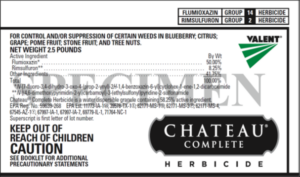A colleague recently emailed me a label for a new herbicide, Chateau® Complete (Figure 1). I first applied Chateau® 18 years ago, and the label that landed in my inbox looked very familiar. It took me a minute to figure out how this was different from previous formulations (Figure 2). “Chateau® Complete” is actually a premix of two active ingredients: flumioxazin (Chateau®) and rimsulfuron (Matrix®). While Chateau® SW (dry formulation) and Chateau® EZ (liquid formulation) are labeled in some two dozen crops, the use of Chateau® Complete is far more restrictive and limited to blueberries, citrus, grape, pome fruit, stone fruit, and tree nuts.

Figure 1. Chateau® Complete herbicide containing two active ingredients, flumioxazin and rimsulfuron.
If you are already confused by three formulations of Chateau®, you are in good company. As herbicide formulations evolve and become more complex, it can be a lot to keep straight- even for a weed scientist or agrochemical salesperson. Here are a couple tips to help you avoid a costly misapplication:
Tip 1: Double check the active ingredients and the registered crop uses on the label.
This is the quickest and easiest way to know “what’s in the jug?” and which crops it can be applied to.
Tip 2: Confirm the concentration and use rate.
One trend in herbicides and other everyday products is increasing concentration- squeezing more active ingredient in the same size jug. Just look at the latest formulation of Roundup®, PowerMax 3. It contains 5.88 pounds of glyphosate per gallon. Older formulations (PowerMax® or PowerMax® II) contain 5.5 pounds of glyphosate per gallon. That is a pretty subtle difference compared to the two formulations of Stinger® herbicide available today. The older formulation labeled for fruit crops with numerous 24C Special Local Needs labels, contains 3 pounds of clopyralid per gallon. The new Stinger® HL formulation contains 5 pounds of clopyralid per gallon. In other words, the amount of herbicide you spray across an acre will vary based on the product’s formulation.
Tip 3: Be aware that some formulation names are more for marketing and less for function.
When I was first learning about herbicide formulations, the letters that accompanied the product name were very practical. “L” meant “liquid”. “EC” meant “emulsifiable concentrate”. “WP” meant “wettable powder”. These letters told the applicator important information about the formulated product and had implications for things such as mixing order when applying a tank-mix.
In recent years, these letters have become harder and harder to follow. Chateau® EZ was named “EZ” because the product was formulated to make the transition from dry Chateau SW to liquid EZ simple (or “easy”). If you used to apply 2 dry ounces of Chateau SW, you could simply apply 2 liquid ounces of Chateau EZ instead. The “HL” in “Stinger® HL” stands for “high load”, indicating its more highly concentrated formulation compared to “Stinger®”. The “XL” in Goal® 2XL is a nod to its “extra-long” control of weeds.
In construction, the adage is to “measure twice and cut once”. When it comes to the ever-changing world of agrochemicals, we would be wise to give the label an extra look before we spray.
